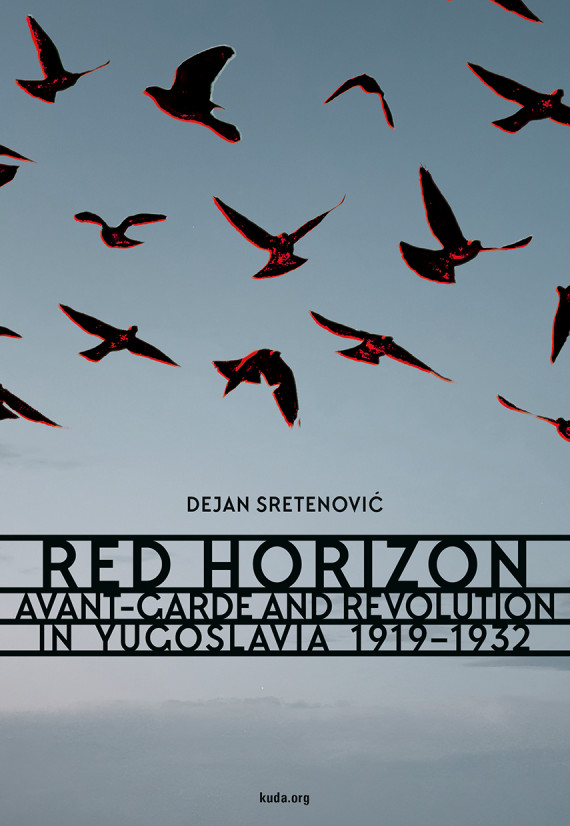Dejan Sretenović: Red Horizon: The Avant-Garde and Revolution in Yugoslavia, 1919–1932 (2021)
Filed under book | Tags: · 1920s, art history, avant-garde, communism, constructivism, dada, expressionism, left, politics, surrealism, yugoslavia

“Red Horizon is the first study to focus on the Yugoslav avant-gardes from the perspective of the history of left-wing political ideas. Bearing in mind that the Yugoslav avant-gardes were politically oriented towards the radical left, and considered the aesthetic revolution an integral part of the social revolution, the book explores the modes of manifestation of the ideas of Marxism and anarchism in the programmes and activities of the avant-gardes, ranging from Expressionism, through Zenitism, Dada, Hipnism, Constructivism to Surrealism. The policies of the Yugoslav avant-gardes are considered in the context of European avant-garde currents and ideational struggles on the left cultural front, as well as in the light of the development of Marxist aesthetics and the attitudes organised Communism assumed towards modern art. The book is structured in the form of a historical-theoretical narrative, starting from the interpretation of the avant-garde and Communism as the two great epic narratives of the 20th century, and telling of the rebellions, dreams, conflicts, victories and defeats of those who wanted to radically change the society and art of their epoch.”
Publisher kuda.org, Novi Sad, 2021
Red Publications series
Translated by Katarina Radović
ISBN 9788688567244
228 pages
PDF (4 MB)
Comment (0)Bauhaus Photography (1982/1985)
Filed under book | Tags: · 1920s, 1930s, art, bauhaus, photography, typography

“These five hundred photographs are a record of Bauhaus activities and experiments during the 1920s and early 1930s. Most of the photographs were taken by artists-painters like Fritz Kuhr and Werner Siedhoff, designers Heinz Loew and Herbert Bayer, Bauhaus masters Hannes Meyer and Joosst Schmidt – who were not self-conscious photographers but who wanted to work with a new technology.
The book supplements visual material already published in Hans Wingler’s monumental Bauhaus and presents the school’s more human side. Some of these photographs have never been published before, while others have not been published since the period in which they were made.
Part I consists of over 100 ‘artistic’ images, a listing of Bauhaus photography exhibits, an example of a Dessau Bauhaus lesson plan, including photography, and essays on various aspects of photography by Peterhans, Moholy, Vordemberge-Gildewart, Ernst Kallai, Fritz Kuhr, Willi Baumeister, Adolf Behne, Max Burchartz, Will Grohmann, and Ludwig Kassack. There is also a section on the use of photography with typography.
Part II is a Bauhaus album – nearly 400 illustrations of applied photography documenting the Bauhaus buildings, classroom projects, or day-today activities of students and faculty.”
First published as Bauhaus Fotografie, Marzona, Düsseldorf, 1982
Edited by Egidio Marzona and Roswitha Fricke
Translated by Harvey Mendelsohn and Frederick Samson
Foreword by Eugene Prakapas
Publisher MIT Press, 1985
ISBN 0262132028, 9780262132022
xi+315 pages
via x
Review: Clark V. Poling (Design Issues, 1986).
PDF (32 MB)
Comment (0)Deborah Ascher Barnstone: Beyond the Bauhaus: Cultural Modernity in Breslau, 1918-33 (2016)
Filed under book | Tags: · 1920s, architecture, art history, avant-garde, cultural history, modernism, urbanism, weimar republic, wroclaw

“Although the Breslau arts scene was one of the most vibrant in all of Weimar-era Germany, it has largely disappeared from memory. Studies of the influence of Weimar culture on modernism have focused almost exclusively on Berlin and the Dessau Bauhaus, yet the advances that occurred in Breslau affected nearly every intellectual field, forming the basis for aesthetic modernism internationally and having an enduring impact on visual art and architecture. Breslau boasted a thriving modern arts scene and one of the premier German arts academies of the day until the Nazis began their assault on so-called degenerate art. This book charts the cultural production of Breslau-based artists, architects, art collectors, urban designers, and arts educators who operated in the margins of Weimar-era cultural debates. Rather than accepting the radical position of the German avant-garde or the reactionary position of German conservatives, many Breslauers sought a middle ground.
This richly illustrated volume is the first book in English to address this history, constituting an invaluable addition to the literature on the Weimar period. Its readership includes scholars of German history, art, architecture, urban design, planning, collecting, and exhibition history; of the avant-garde, and of the development of arts academies and arts pedagogy.”
Publisher University of Michigan Press, 2016
Social History, Popular Culture, and Politics in Germany series
Creative Commons BY-NC-ND 4.0
ISBN 0472119907, 9780472119905
xi+256 pages

